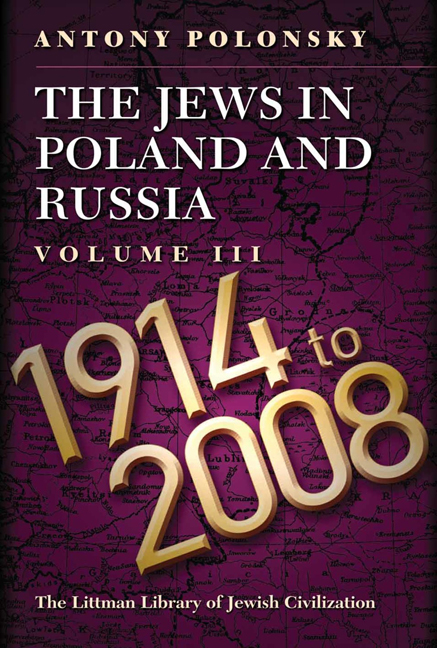Book contents
- Frontmatter
- Dedication
- Acknowledgements
- Contents
- List of Maps
- List of Tables
- Note on Transliteration
- Note on Place Names
- Maps
- General Introduction
- PART I FROM THE FIRST WORLD WAR TO THE SECOND
- PART II WAR AND GENOCIDE, 1939–1944
- PART III FROM THE END OF THE SECOND WORLD WAR TO THE COLLAPSE OF THE COMMUNIST SYSTEM
- EPILOGUE JEWS IN EASTERN EUROPE AND RUSSIA SINCE THE END OF COMMUNISM
- Conclusion
- Glossary
- Bibliography
- Index
19 - Jews in Poland since the End of Communism
- Frontmatter
- Dedication
- Acknowledgements
- Contents
- List of Maps
- List of Tables
- Note on Transliteration
- Note on Place Names
- Maps
- General Introduction
- PART I FROM THE FIRST WORLD WAR TO THE SECOND
- PART II WAR AND GENOCIDE, 1939–1944
- PART III FROM THE END OF THE SECOND WORLD WAR TO THE COLLAPSE OF THE COMMUNIST SYSTEM
- EPILOGUE JEWS IN EASTERN EUROPE AND RUSSIA SINCE THE END OF COMMUNISM
- Conclusion
- Glossary
- Bibliography
- Index
Summary
‘Are you a Pole or a Jew?’, asked the specialist, putting his pistol on the table.
‘Both a Pole, and a Jew,’ responded Leon.
‘One is either a Pole or a Jew.’
‘I am an example that it is possible to be both one and the other.’
‘And you are connected with Polish culture?’
‘Yes.’
‘Then recite something from Pan Tadeusz.’
‘Jankiel through the whole winter stayed one knew not where; now suddenly with the main staff of the military he made his appearance …’
HENRYK GRYNBERG, Memorbuch, 2000I do not fear the return of communism, but there is a danger of new conflicts between chauvinism and nationalist extremism on the one hand and tolerance, liberalism and Christian values on the other.
WŁADYSŁAW BARTOSZEWSKI on receiving the Heinrich Heine Prize, December 1996POLAND SINCE 1989
FOR the first decade and a half after the collapse of the communist political system, Poland appeared to have achieved a degree of political stability, in spite of the bewildering rapidity with which parties arose, split, and disappeared. It rested on the emergence of two groups, one deriving from the Solidarity movement, sometimes called the post-Solidarity camp, and the other deriving from the former Polish United Workers’ Party (Polska Zjednoczona Partia Robotnicza, PZPR), which dissolved itself in 1990 and was transformed, more or less convincingly, into a social democratic party of the west European type, the Democratic Left Union (Sojusz Lewicy Demokratycznej, SLD).
Commentators have stressed the ideological differences between these two groupings. According to the social psychologist Janusz Reykowski, two concepts of democracy developed in post-communist Poland. One saw the democratic system as primarily concerned to ensure its citizens the greatest amount of freedom; the other saw democracy as primarily concerned to provide the maximum security for them. Those who favoured the first concept look to the socio-economic situation to provide opportunity for advancement; those who favoured the second are primarily preoccupied with the dangers inherent in it and the need to provide protection for the weaker members of society. The first, Reykowski identifies with the post-Solidarity camp, which held power from 1989 to 1993 and again between 1997 and 2001, and the second, with the post-communist camp, which was in power between 1993 and 1997 and from September 2001 to 2005, and whose most formidable politician, Aleksander Kwaśniewski, twice won the presidency, in 1995 and 2000.
- Type
- Chapter
- Information
- The Jews in Poland and RussiaVolume III: 1914 to 2008, pp. 809 - 830Publisher: Liverpool University PressPrint publication year: 2012

